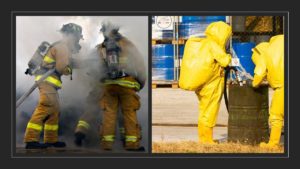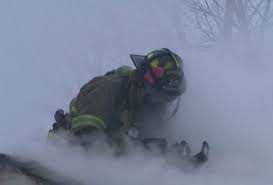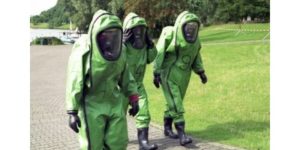By: Robert Avsec, Executive Fire Officer
Here’s a scenario for you to consider:
A worker encounters an emergent work environment in a structure. The worker has no previous knowledge of the physical layout of

Which picture depicts firefighters dealing with one hazardous material? Which one is showing firefighters exposed to multiple chemicals, chemical compounds, and carcinogens? Which firefighters are properly protected?
the structure, how the structure is occupied, what contents and furnishing may be inside, or how the situation began.
Further, the worker commits to a course of action taking them into an environment filled with visible smoke and an unknown number of toxic chemicals, chemical compounds, and carcinogens, most of which are in gaseous form (See Related: It’s in the smoke: cancer-causing compounds and contaminants). And the worker commits to that action while wearing protective clothing that’s not accepted protection against those toxic chemicals, chemical compounds, and carcinogens in gaseous form.
Most of these actions, if not all, would be violations of labor laws, rules, and regulations regarding worker safety and an employer’s legal obligations to provide a safe work environment. And yet, the above is pretty much the scenario for every residential structure fire where firefighters make an interior fire attack.
Labor laws, rules, and regulations
In the United States we have extensive federal and state laws and regulations in place to protect the health and safety of workers on the job. You may be familiar with OSHA (Occupational Safety and Health Administration), yes?
Those protective laws and rules and regulations did not come about because the companies that employed workers wanted them. They came about because of deaths and injuries in the work place. Deaths and injuries caused by, not only unsafe, but in many cases downright dangerous working conditions like those chronicled in Upton Sinclair’s muckraking book, The Jungle (Sinclair went undercover for seven weeks, gathering data on the horrific labor practices of the Chicago meat packing industry). And it was other “muckrakers” like Sinclair (we now call them investigative journalists) and labor activists who eventually helped get those legal protections for workers.
So, where are the laws and regulations to protect firefighters from the increased risk of cancer associated with exposures to  hazardous materials during structural firefighting? They are not NFPA standards like NFPA 1710: Standard for the Organization and Deployment of Fire Suppression Operations, Emergency Medical Operations, and Special Operations to the Public by Career Fire Departments.
hazardous materials during structural firefighting? They are not NFPA standards like NFPA 1710: Standard for the Organization and Deployment of Fire Suppression Operations, Emergency Medical Operations, and Special Operations to the Public by Career Fire Departments.
NFPA standards are consensus standards that can be followed by fire departments, or not. They do not have the force of law behind them.
But there is OSHA’s HAZWOPER standard.
Who is covered by that standard?
This is from the Scope of OSHA 29 CFR §§ 1910.120 – Hazardous Waste Operations and Emergency Response (HAZWOPER):
This section covers the following operations [next paragraph], unless the employer can demonstrate that the operation does not involve employee exposure or the reasonable possibility for employee exposure to safety or health hazards. (1910.120(a)(1)
The HAZWOPER standard applies to five distinct groups of employers and their employees. This includes any employees who are exposed or potentially exposed to hazardous substances — including hazardous waste — and who are engaged in one of the following operations as specified by 1910.120(a)(1)(i-v) and 1926.65(a)(1)(i-v) [In the interest of brevity, I’ve only included the one of the five that I believe speaks to firefighters and interior structural firefighting].
Emergency response operations for releases of, or substantial threats of releases of, hazardous substances regardless of the location of the hazard. 1910.120(a)(1)(v)
Based upon what we already know, and continue to learn, structure fires–particularly fires in residential structures–produce  hazardous materials in the form of smoke containing (among many others) these chemicals, chemical compounds, and carcinogens [1]:
hazardous materials in the form of smoke containing (among many others) these chemicals, chemical compounds, and carcinogens [1]:
- Acrolein. Acrolein produces intense irritation to the eye and mucous membranes of the respiratory tract. Acute exposures may result in bronchial inflammation, resulting in bronchitis or pulmonary edema.
- Carbon Monoxide (CO). CO is present in all fire environments as a product of incomplete combustion and decreases the oxygen transport of the blood, which results in an inadequate supply of oxygen to the tissues.
- Formaldehyde. Formaldehyde is classified as a probable carcinogen and adverse health effects due to formaldehyde may occur after exposure by inhalation, ingestion or skin contact. Eye irritation can occur at concentrations of 0.01-2.0 ppm, irritation of the nose and throat at 1.0-3.0 ppm, and severe respiratory symptoms at 10-20 ppm.
- Glutaraldehyde. Glutaraldehyde is a potent sensory irritant with the capability to cross-link or fix proteins.
In addition, these harmful substances exceeded published short-term exposure limit values [2]:
- Benzene (a known carcinogen)
- Nitrogen dioxide
- Sulfur dioxide
See Related: Why interior structural firefighting will be obsolete by 2030
It’s our business to know
Fire department leaders must make it their business to know and understand the provisions and requirements of 1910.120(q), Emergency response program to hazardous substance releases. That paragraph covers employers whose employees are engaged in emergency response regardless of where it occurs except that it does not cover employees engaged in those other four operations (the ones I omitted for brevity that covered emergency responses to specific facilities where hazardous materials are manufactured, stored, or prepared for transport).
I say that fire service leaders need to know and understand the requirements of Paragraph q in the standard, but more importantly, they must understand how those requirements impact interior structural firefighting. Particularly in the context of what we know, and continue to learn, about the hazardous materials incident presented by an interior structure fire, especially one that has progressed past the incipient stage of fire growth.
See Related: A new structure fire response paradigm
Look, I’ve made this connection between the HAZWOPER standard and interior structural firefighting with about an hour’s worth of research. How long do you think it’s going to take for an attorney—and their legal team—representing a firefighter who’s developed cancer on the job to develop a solid case that their client’s cancer was caused by the inappropriate PPE and unnecessary exposure to toxic chemicals, chemical compounds, and carcinogens?
The “storm clouds are gathering.” Do we see the developing storm?
References
- Dawn M. Bolstad-Johnson, D., Burgess, J., Crutchfield, C., Storment, S., Gerkin, R., and Wilson, J. Characterization of Firefighter Exposures During Fire Overhaul. American Industrial Hygienist Association Journal. September/October 2000. pp. 636-641.
- Ibid.
 Fire & EMS Leader Pro The job of old firefighters is to teach young firefighters how to become old firefighters!
Fire & EMS Leader Pro The job of old firefighters is to teach young firefighters how to become old firefighters!